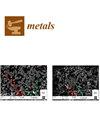Understanding the High-Temperature Deformation Behaviors in Additively Manufactured Al6061+TiC Composites via In Situ Neutron Diffraction
IF 2.5
3区 材料科学
Q3 MATERIALS SCIENCE, MULTIDISCIPLINARY
引用次数: 0
Abstract
Aluminum matrix composites (AMCs) are designed to enhance the performance of conventional aluminum alloys for engineering applications at both room and elevated temperatures. However, the dynamic phase-specific deformation behavior and load-sharing mechanisms of AMCs at elevated temperatures have not been extensively studied and remain unclear. Here, in situ neutron diffraction experiments are employed to reveal the phase-specific structure evolution of additively manufactured Al6061+TiC composites under compressive loading at 250 °C. It is found that the addition of a small amount of nano-size TiC significantly alters the deformation behavior and increases the strength at 250 °C in comparison to the as-printed Al6061. Unlike the two-stage behavior observed in Al6061, the Al6061+TiC composites exhibit three stages during compression triggered by changes in the interphase stress states. Further analysis of Bragg peak intensity and broadening reveals that the presence of TiC alters the dislocation activity during deformation at 250 °C by influencing dislocation slip planes and promoting dislocation accumulation. These findings provide direct experimental observations of the phase-specific dynamic process in AMCs under deformation at an elevated temperature. The revealed mechanisms provide insights for the future design and optimization of high-performance AMCs.通过原位中子衍射了解增材制造 Al6061+TiC 复合材料的高温变形行为
铝基复合材料(AMC)旨在提高传统铝合金在室温和高温下的工程应用性能。然而,AMC 在高温下的特定相位动态变形行为和负载分担机制尚未得到广泛研究,目前仍不清楚。本文采用原位中子衍射实验揭示了加成制造的 Al6061+TiC 复合材料在 250 °C 压缩负载下的特定相结构演变。研究发现,与原样印刷的 Al6061 相比,添加少量纳米尺寸的 TiC 会显著改变 250 ℃ 下的变形行为并提高强度。与在 Al6061 中观察到的两阶段行为不同,Al6061+TiC 复合材料在压缩过程中表现出由相间应力状态变化引发的三个阶段。对布拉格峰强度和展宽的进一步分析表明,TiC 的存在通过影响位错滑移面和促进位错累积,改变了 250 °C 变形过程中的位错活动。这些发现提供了对 AMC 在高温变形下特定相动态过程的直接实验观察。所揭示的机制为今后设计和优化高性能 AMC 提供了启示。
本文章由计算机程序翻译,如有差异,请以英文原文为准。
求助全文
约1分钟内获得全文
求助全文
来源期刊

Metals
MATERIALS SCIENCE, MULTIDISCIPLINARY-METALLURGY & METALLURGICAL ENGINEERING
CiteScore
4.90
自引率
13.80%
发文量
1832
审稿时长
1.5 months
期刊介绍:
Metals (ISSN 2075-4701) is an open access journal of related scientific research and technology development. It publishes reviews, regular research papers (articles) and short communications. Our aim is to encourage scientists to publish their experimental and theoretical results in as much detail as possible. Therefore, there is no restriction on the length of the papers. The full experimental details must be provided so that the results can be reproduced. Metals provides a forum for publishing papers which advance the in-depth understanding of the relationship between the structure, the properties or the functions of all kinds of metals.
 求助内容:
求助内容: 应助结果提醒方式:
应助结果提醒方式:


